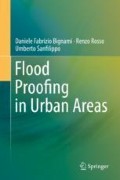Abstract
A building stressed by water flow is affected by three main actions: (i) buoyancy, (ii) hydrostatic force, (iii) hydrodynamic force. The first one, sometimes also called Archimedes force, is due to the tendency of a submersed building to float because of the weight of the water that could be in its volume. The second one is due to the mass of water as (statically in quiet) that is in direct contact with the structure, it is isotropic and its direction is locally perpendicular to the contact surface, causing effects on both the vertical elements of the structure (walls, pillars and so on) and on the horizontal elements of the structure (girders, roofs and so on). The third one is provided as the result of the forces related to the water movement and affects the upstream surface of the structure, that is the surface directly facing the flow: it tends to drag the structure toward the flow direction and to scour the foundations, with an additional destabilizing effect due to local whirling eddies and possible negative pressure on the downstream surfaces of the structure.
Access this chapter
Tax calculation will be finalised at checkout
Purchases are for personal use only
Notes
- 1.
The corresponding allowable stress values for a pilaster of 5 × 10 cm are respectively 347 and 694 Nm.
References
Black RD (1975) Flood proofing rural residences. A Project Agnes Report, Pennsylvania New York State College of Agriculture and Life Sciences, Ithaca. Prepared for Economic Development Administration, Washington, DC, Office of Technical Assistance
Clausen L, Clark PB (1990) The development of criteria for predicting dambreak flood damages using modelling of historical dam failures. In: White WR (ed) International Conference on River Flood Hydraulics, Hydraulics Research Limited, 17–20 September 1990. Wiley, Chichester, pp 369–380
Harrison S (1864) A complete history of the great flood at Sheffield on March 11 and 12, 1864
Lardieri AC (1975) Flood proofing regulations for building codes. J Hydraul Div 101(HY9):1155–1169
Lorenzen RT, Black RD, Nieber JL (1975) Design aspects of buildings for flood plain locations. ASAE Paper, 68th Annu Meet, Davis, 22–25 June 1975 ASAE St. Joseph, Mich 20p Paper: 75-4037. p 19
Maijala T (2001) RESCDAM: development of rescue actions based on dam-break flood analysis. Final report, grant agreement no. Subv 99/52623 Community Action Programme in the field of civil protection. Finnish Environment Institute, Helsinki
Sangrey DA, Murphy PJ, Nieber JL (1975) Evaluating the impact of structurally interrupted flood plain flows. Cornell University. Prepared for: Office of Water Research and Technology. Distributed by: NTIS. PB-247 552
Smith DI (1991) Extreme floods and dam failure inundation implications for loss assessment. In: Proceedings of a Seminar “Natural and Technological Hazards: Implications for the Insurance Industry”. University of New England, Armidale, NSW, pp 149–165
Smith DI (1994) Flood damage estimation – a review of urban stage-damage curves and loss functions. Water SA 20:231–238
Author information
Authors and Affiliations
Rights and permissions
Copyright information
© 2019 Springer Nature Switzerland AG
About this chapter
Cite this chapter
Bignami, D.F., Rosso, R., Sanfilippo, U. (2019). Flood Impact on Buildings. In: Flood Proofing in Urban Areas. Springer, Cham. https://doi.org/10.1007/978-3-030-05934-7_2
Download citation
DOI: https://doi.org/10.1007/978-3-030-05934-7_2
Published:
Publisher Name: Springer, Cham
Print ISBN: 978-3-030-05933-0
Online ISBN: 978-3-030-05934-7
eBook Packages: Earth and Environmental ScienceEarth and Environmental Science (R0)

